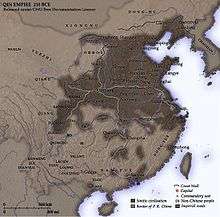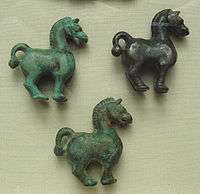Ordos culture
The Ordos culture was a culture occupying a region centered on the Ordos Loop (modern Inner Mongolia, China) during the Bronze and early Iron Age from the 6th to 2nd centuries BCE. The Ordos culture is known for significant finds of Scythian art and is thought to represent either the easternmost extension of Indo-European Eurasian nomads, such as the Saka, or to represent a culture formed by Turkic peoples.[1][2][3][4] Under the Qin and Han dynasties, from the 6th to 2nd centuries BCE, the area came under at least nominal control of contemporaneous Chinese states.

Background
Equestrian nomads from the north-west occupied the area previously settled by the Zhukaigou culture from the 6th to the 2nd century BCE before being driven away by the Xiongnu.[5] The Ordos Plateau was covered by grass, bushes, and trees and was sufficiently watered by numerous rivers and streams to produce rich grazing lands.[6] At the time, it contained the best pasture lands on the Asian Steppe.[7] However, it has now mostly turned to the Ordos Desert through a combination of overgrazing and climatic change.
Characteristics
The Ordos are mainly known from their skeletal remains and artifacts. The Ordos culture of about 500 BCE to 100 CE is known for its "Ordos bronzes", blade weapons, finials for tent-poles, horse gear, and small plaques and fittings for clothes and horse harness, using animal style decoration with relationships both with the Scythian art of regions much further west, and also Chinese art. Its relationship with the Xiongnu is controversial; for some scholars they are the same and for others different.[8] Many buried metal artefacts have emerged on the surface of the land as a result of the progressive desertification of the region.[9]
The Ordos are thought to be the easternmost of the Iranian peoples of the Eurasian Steppe, just to the east of the better-known Yuezhi, also an Indo-European people.[2][3] Because the people represented in archaeological finds tend to display Europoid features, also earlier noted by Otto J. Maenchen-Helfen,[10] Iaroslav Lebedynsky suggests the Ordos culture had "a Scythian affinity".[11][12] Other scholars have associated it with the Yuezhi.[6] The weapons found in tombs throughout the steppes of the Ordos are very close to those of the Scythians and Saka.[6][13] A Turkic origin is also suggested by some historians.[14]
Contact with neighbouring peoples
While the ethnolinguistic origins and character of the Ordos culture are unknown, the population appears to have been significantly influenced either by Indo-European cultures, or by Turkic peoples.[2][15] However, the art of the Ordos culture appears to have influenced that of the Donghu people (Chinese: 東胡), a Mongolic-speaking nomadic tribe located to the east, suggesting that the two had close ties.[16] (The Donghu may also have been connected to a people known as the Northern Di in Chinese annals.
The Ordos population was also in contact – and reportedly often at war – with the pre-Han and Han peoples. The Ordos culture covered, geographically, regions later occupied by the Han, including areas just north of the later Great Wall of China and straddling the northernmost hook of the Yellow River.
To the west of the Ordos culture was another Indo-European people, the Yuezhi, although nothing is known of relations between the two. (The Yuezhi were later vanquished by the Xiongnu and Wusun, who reportedly drove them westward, out of China; a subgroup of the Yuezhi is widely believed to have migrated to South Central Asia, where it constituted the ruling elite of the Kushan Empire.)
Appearance of the Xiongnu
In Chinese accounts, the Xiongnu first appear at Ordos in the Yi Zhou Shu and Classic of Mountains and Seas during the Warring States period before it was occupied by the states of Qin and Zhao. It is generally thought to be their homeland; however, when exactly they came to occupy the region is unclear and archaeological finds suggest it might have been much earlier than traditionally thought.[17]
As the Xiongnu expanded southward into Yuezhi territory around 160 BCE under Modun, the Yuezhi in turn defeated the Sakas and pushed them away at Issyk Kul. It is thought the Xiongnu also occupied the Ordos area during the same period, when they came in direct contact with the Chinese. From there, the Xiongnu conducted numerous devastating raids into Chinese territory (167, 158, 142, 129 BCE).[18]
The Han–Xiongnu War began with Emperor Wu of Han, and the Han colonized the area of the Ordos as the commandery of Shuofang in 127 BCE. Prior to this campaign, there were already earlier commanderies established by Qin and Zhao before they were overrun by the Xiongnu in 209 BCE.[19]
Artifacts
Ordos bronzes from the British Museum (Asian Gallery):
- Bronze pole top, Ordos, 6th–5th century BCE
- Silver horse, Ordos, 4th–1st century BCE
- Belt buckle, Ordos, 3rd–1st century BCE
 Ordos bronze horses, 5th–3rd century BCE
Ordos bronze horses, 5th–3rd century BCE
References
Citations
| Wikimedia Commons has media related to Ordos culture. |
- Lebedynsky 2007, p. 131
- Macmillan Education 2016, p. 369 "From that time until the HAN dynasty the Ordos steppe was the home of semi-nomadic Indo-European peoples whose culture can be regarded as an eastern province of a vast Eurasian continuum of Scytho-Siberian cultures."
- Harmatta 1992, p. 348: "From the first millennium b.c., we have abundant historical, archaeological and linguistic sources for the location of the territory inhabited by the Iranian peoples. In this period the territory of the northern Iranians, they being equestrian nomads, extended over the whole zone of the steppes and the wooded steppes and even the semi-deserts from the Great Hungarian Plain to the Ordos in northern China."
- https://en.unesco.org/silkroad/sites/silkroad/files/knowledge-bank-article/4%20Indo-European%20indications%20of%20Turkic%20ancestral%20home%20-%20Copy.pdf
- Bunker 2002, p. 26-29
- Hanks & Linduff 2009, pp. 284–286
- Beckwith 2009, p. 71
- Compare this and this account, both from the 1970s. Bunker, 200, sees them as the same, or rather the Ordos people as a subgroup of the Xiongnu.
- Bunker 2002, p. 200
- Maenchen-Helfen 1973, pp. 369–375
- Lebedynsky 2007, p. 125 "Europoid faces in some depictions of the Ordos, which should be attributed to a Scythian affinity"
- Lebedynsky 2007, p. 125 "The Mongoloid types of the Transbaikal area and Central and Eastern Mongolia are strongly contrasted with the Europoid type displayed at the same time by the Scythian nomads occupying Western Mongolia and their predecessors of the Bronze age."
- Lebedynsky 2007, p. 127
- https://en.unesco.org/silkroad/sites/silkroad/files/knowledge-bank-article/4%20Indo-European%20indications%20of%20Turkic%20ancestral%20home%20-%20Copy.pdf
- https://en.unesco.org/silkroad/sites/silkroad/files/knowledge-bank-article/4%20Indo-European%20indications%20of%20Turkic%20ancestral%20home%20-%20Copy.pdf
- Lebedynsky, p.124
- Ma 2005, p. 220-225
- Lebedymsky p131
- Ma 2005, p. 224
Sources
- Beckwith, Christopher I. (16 March 2009). Empires of the Silk Road: A History of Central Eurasia from the Bronze Age to the Present. Princeton University Press. ISBN 1400829941. Retrieved February 18, 2015.CS1 maint: ref=harv (link)
- Bunker, Emma C. (2002). Nomadic art of the eastern Eurasian steppes: the Eugene V. Thaw and other New York collections (fully available online). New York: The Metropolitan Museum of Art. ISBN 9780300096880.CS1 maint: ref=harv (link)
- Hanks, Brian K.; Linduff, Katheryn M. (August 30, 2009). Social Complexity in Prehistoric Eurasia: Monuments, Metals and Mobility. Cambridge University Press. ISBN 0521517125. Retrieved March 13, 2015.CS1 maint: ref=harv (link)
- Harmatta, János (1992). "The Emergence of the Indo-Iranians: The Indo-Iranian Languages". In Dani, A. H.; Masson, V. M. (eds.). History of Civilizations of Central Asia: The Dawn of Civilization: Earliest Times to 700 B. C. (PDF). UNESCO. pp. 346–370. ISBN 978-92-3-102719-2. Retrieved 29 May 2015.CS1 maint: ref=harv (link)
- Lebedynsky, Yaroslav (2007). Les nomades. Éditions Errance. ISBN 9782877723466.CS1 maint: ref=harv (link)
- Macmillan Education (2016). Macmillan Dictionary of Archaeology. Macmillan International Higher Education. ISBN 1349075892.CS1 maint: ref=harv (link)
- Maenschen-Helfen, Otto (1973). The World of the Huns: Studies in Their History and Culture. University of California Press. ISBN 0520015967. Retrieved February 18, 2015.CS1 maint: ref=harv (link)
- Ma, Liqing (2005). The Original Xiongnu, An Archaeological Exploration of the Xiongnu's History and Culture. Hohhot: Inner Mongolia University Press. ISBN 7-81074-796-7.
External links
- The Relief Plaques of Eastern Eurasia and China - The Ordos Bronzes - video by Sir John Boardman, 3m 47 sec